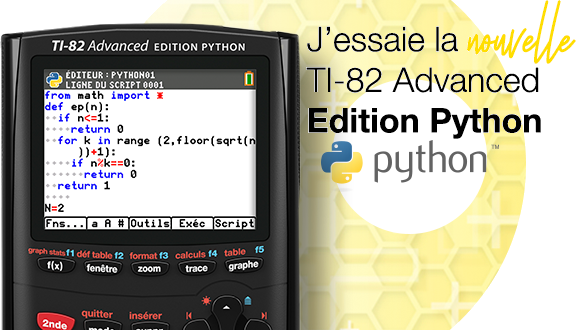Pour la rentrée 2011, Casio sortait les premières calculatrices à écran couleur 16 bits (65536 couleurs), la fx-CG10 pour l'Amérique du Nord et la fx-CG20 pour le reste du monde, annoncées quelques semaines avant que Texas Instruments ne fasse de même avec les TI-Nspire CX.

 Pour la rentrée 2017, Casio a remplacé ces modèles par la Graph 90+E pour la France, et la fx-CG50 pour le reste du monde.
Pour la rentrée 2017, Casio a remplacé ces modèles par la Graph 90+E pour la France, et la fx-CG50 pour le reste du monde.
La Casio Graph 90+E est une formidable calculatrice qui est selon nous loin de rencontrer le succès qu'elle mériterait. Il s'agit en gros d'une version couleur de la Graph 35+E II, calculatrice numéro 1 des ventes au lycée encore en 2019. Elle reste entièrement compatible avec cette dernière au niveau des manipulations puisque disposant des mêmes menus et claviers, et donc très facile à prendre en main.
La calculatrice dispose d'un superbe écran large de 396×224 pixels. Précisons pour autant que Casio ne s'est pas contenté d'une simple coloration rapide de l'interface Graph 35+E II. Il y a eu tout un travail graphique, et chaque application dispose de son propre thème graphique dédié allant même jusqu'à inclure une très discrète mais non moins esthétique image de fond d'écran.
Le processeur 32 bits n'est pas en reste, un SH4 cadencé à 117,96 MHz (le même que sur le modèle haut de gamme fx-CP400+E), comptant parmi les plus puissants sur calculatrices. De plus le processeur est overclockable logiciellement, et peut atteindre dans les 270 MHz sans difficulté.
Enfin, contrairement aux habitudes de la concurrence historique, les calculatrices Graph 90+E et Graph 35+E II autorisent d'origine le développement d'applications. Tu peux coder ta propre application en langage C et/ou assembleur, l'installer sur ta calculatrice aussi facilement qu'une application officielle et même la partager avec le monde entier. Les applications ainsi rajoutées ne seront juste pas accessibles une fois la calculatrice passée en mode examen.

 Pour la rentrée 2017, Casio a remplacé ces modèles par la Graph 90+E pour la France, et la fx-CG50 pour le reste du monde.
Pour la rentrée 2017, Casio a remplacé ces modèles par la Graph 90+E pour la France, et la fx-CG50 pour le reste du monde.La Casio Graph 90+E est une formidable calculatrice qui est selon nous loin de rencontrer le succès qu'elle mériterait. Il s'agit en gros d'une version couleur de la Graph 35+E II, calculatrice numéro 1 des ventes au lycée encore en 2019. Elle reste entièrement compatible avec cette dernière au niveau des manipulations puisque disposant des mêmes menus et claviers, et donc très facile à prendre en main.
La calculatrice dispose d'un superbe écran large de 396×224 pixels. Précisons pour autant que Casio ne s'est pas contenté d'une simple coloration rapide de l'interface Graph 35+E II. Il y a eu tout un travail graphique, et chaque application dispose de son propre thème graphique dédié allant même jusqu'à inclure une très discrète mais non moins esthétique image de fond d'écran.
Le processeur 32 bits n'est pas en reste, un SH4 cadencé à 117,96 MHz (le même que sur le modèle haut de gamme fx-CP400+E), comptant parmi les plus puissants sur calculatrices. De plus le processeur est overclockable logiciellement, et peut atteindre dans les 270 MHz sans difficulté.
Enfin, contrairement aux habitudes de la concurrence historique, les calculatrices Graph 90+E et Graph 35+E II autorisent d'origine le développement d'applications. Tu peux coder ta propre application en langage C et/ou assembleur, l'installer sur ta calculatrice aussi facilement qu'une application officielle et même la partager avec le monde entier. Les applications ainsi rajoutées ne seront juste pas accessibles une fois la calculatrice passée en mode examen.
Aujourd'hui nous allons parler images sur Graph 90+E et fx-CG10/20/50, un vaste sujet. Ces calculatrices gèrent des images d'extension .g3p, qui peuvent être au choix :
Les images .g3p utilisent un format propriétaire de Casio, qui a existé en 2 versions successives :
 Casio diffuse à l'attention des enseignants depuis 2011 un convertisseur d'images pour Windows et Mac, le Casio Picture Conversion Engine. Officiellement il s'agit d'une diffusion privée, le téléchargement étant verrouillé par un mot de passe et le logiciel nécessitant en prime un numéro de licence pour fonctionner. Informations obtenables uniquement sur remplissage correct du formulaire.
Casio diffuse à l'attention des enseignants depuis 2011 un convertisseur d'images pour Windows et Mac, le Casio Picture Conversion Engine. Officiellement il s'agit d'une diffusion privée, le téléchargement étant verrouillé par un mot de passe et le logiciel nécessitant en prime un numéro de licence pour fonctionner. Informations obtenables uniquement sur remplissage correct du formulaire.
En pratique tu pouvais quand même l'utiliser. Dès 2011 fxdev avait en effet publié le courriel qu'il avait reçu de Casio, révélant à la fois le mot de passe ainsi qu'un numéro de licence visiblement réutilisable, informations reprises depuis sur de très nombreux sites.
Cet outil génère des images en 384×192 pixels, adaptées à la fenêtre graphique. Si ton image utilise un rapport différent, l'outil te donne la possibilité de l'ajuster en hauteur ou en largeur.
- mises en fond d'écran de la fenêtre graphique de certaines applications (graphes, géométrie dynamique)
- affichées sur commande par un programme en langage Basic
Les images .g3p utilisent un format propriétaire de Casio, qui a existé en 2 versions successives :
- CP
- CP0100
 Casio diffuse à l'attention des enseignants depuis 2011 un convertisseur d'images pour Windows et Mac, le Casio Picture Conversion Engine. Officiellement il s'agit d'une diffusion privée, le téléchargement étant verrouillé par un mot de passe et le logiciel nécessitant en prime un numéro de licence pour fonctionner. Informations obtenables uniquement sur remplissage correct du formulaire.
Casio diffuse à l'attention des enseignants depuis 2011 un convertisseur d'images pour Windows et Mac, le Casio Picture Conversion Engine. Officiellement il s'agit d'une diffusion privée, le téléchargement étant verrouillé par un mot de passe et le logiciel nécessitant en prime un numéro de licence pour fonctionner. Informations obtenables uniquement sur remplissage correct du formulaire.En pratique tu pouvais quand même l'utiliser. Dès 2011 fxdev avait en effet publié le courriel qu'il avait reçu de Casio, révélant à la fois le mot de passe ainsi qu'un numéro de licence visiblement réutilisable, informations reprises depuis sur de très nombreux sites.
Cet outil génère des images en 384×192 pixels, adaptées à la fenêtre graphique. Si ton image utilise un rapport différent, l'outil te donne la possibilité de l'ajuster en hauteur ou en largeur.
Le logiciel Casio Picture Conversion Engine n'a hélas pas que des avantages :
Nous souhaitions donc t'offrir un autre convertisseur. Hélas, les formats d'images .g3p sont encore aujourd'hui très mal documentés. Une ébauche de documentation était certes en bonne voie dès 2012, mais hélas l'administrateur de Cemetech était intervenu pour l'interrompre, mettant en avant de supposés contacts chez Casio qui auraient eu des préoccupations par rapport aux examens. Elle reste donc aujourd'hui à l'état d'ébauche très incomplète et insuffisante.
Effectivement à ce sujet, la version CP0100 introduisait le support de 3 obscurcissements binaires différents :
Suggérer l'arrêt total de la documentation était toutefois bien extrême. Il aurait simplement suffi de ne pas documenter d'autre obscurcissement binaire que celui du logiciel Casio Picture Conversion Engine...
Il n'empêche que cette intervention est bien cocasse pour ceux qui connaissent la suite de l'histoire avec le revirement pro-TI du personnage dès 2013, alors que Texas Instruments répondait sur le créneau de Casio avec la TI-84 Plus C Silver Edition très inférieure, une des calculatrices graphiques les plus ratées de chez Texas Instruments. Elle conservait en effet le processeur 8 bits z80 à 15 MHz des TI-84 Plus à écran monochrome 96×64 pixels, mais cette fois-ci pour gérer un écran couleur 16 bits en 320×240 pixels, soit 200 fois plus de données à faire passer dans les circuits à chaque rafraîchissement d'écran ! Absolument tout ramait sur cette machine, l'affichage des menus et même le clavier...
Quoi qu'il en soit, nous subissons aujourd'hui encore les conséquences de cette très regrettable intervention.
- il n'est disponible que pour Windows et Mac là où de plus en plus d'appareils récents utilisent d'autres systèmes d'exploitation
- il nécessite l'installation de la bibliothèque QuickTime qui n'est plus maintenue pour Windows depuis 2016, et dont l'installation devient de plus en plus difficile à réussir
- il générait systématiquement des images maximisées en 384×192 pixels, avec donc un gaspillage de place si ce que tu convertissais n'était pas destiné à occuper tout l'écran
Nous souhaitions donc t'offrir un autre convertisseur. Hélas, les formats d'images .g3p sont encore aujourd'hui très mal documentés. Une ébauche de documentation était certes en bonne voie dès 2012, mais hélas l'administrateur de Cemetech était intervenu pour l'interrompre, mettant en avant de supposés contacts chez Casio qui auraient eu des préoccupations par rapport aux examens. Elle reste donc aujourd'hui à l'état d'ébauche très incomplète et insuffisante.

Effectivement à ce sujet, la version CP0100 introduisait le support de 3 obscurcissements binaires différents :
- pour les images converties avec le logiciel Casio Picture Conversion Engine
- pour les captures d'écran prises directement sur la calculatrice avec
SHIFT
7
- pour les images officielles de Casio, préchargées sur la calculatrice et librement retéléchargeables sur leur site
Suggérer l'arrêt total de la documentation était toutefois bien extrême. Il aurait simplement suffi de ne pas documenter d'autre obscurcissement binaire que celui du logiciel Casio Picture Conversion Engine...
Il n'empêche que cette intervention est bien cocasse pour ceux qui connaissent la suite de l'histoire avec le revirement pro-TI du personnage dès 2013, alors que Texas Instruments répondait sur le créneau de Casio avec la TI-84 Plus C Silver Edition très inférieure, une des calculatrices graphiques les plus ratées de chez Texas Instruments. Elle conservait en effet le processeur 8 bits z80 à 15 MHz des TI-84 Plus à écran monochrome 96×64 pixels, mais cette fois-ci pour gérer un écran couleur 16 bits en 320×240 pixels, soit 200 fois plus de données à faire passer dans les circuits à chaque rafraîchissement d'écran ! Absolument tout ramait sur cette machine, l'affichage des menus et même le clavier...

Quoi qu'il en soit, nous subissons aujourd'hui encore les conséquences de cette très regrettable intervention.

 Dans plusieurs articles précédents nous te présentions img2calc, notre nouveau service en ligne gratuit sur TI-Planet te permettant de convertir tes images pour tes programmes Basic ou scripts Python sur calculatrices TI et Casio fx-CP400/CG500.
Dans plusieurs articles précédents nous te présentions img2calc, notre nouveau service en ligne gratuit sur TI-Planet te permettant de convertir tes images pour tes programmes Basic ou scripts Python sur calculatrices TI et Casio fx-CP400/CG500.Aujourd'hui est un grand jour pour la communauté Casio ! Nous avons réussi, img2calc gère désormais également le format .g3p des Graph 90+E et fx-CG10/20/50 !

 Tu peux donc maintenant enfin convertir librement tes images pour tes activités ou programmes Graph 90+E et fx-CG10/20/50 à partir de n'importe quelle machine dans le monde, plus rien à installer !
Tu peux donc maintenant enfin convertir librement tes images pour tes activités ou programmes Graph 90+E et fx-CG10/20/50 à partir de n'importe quelle machine dans le monde, plus rien à installer ! 
Sont gérées à la fois les versions CP et CP0100 du format, tu peux librement choisir même si à notre connaissance il n'y a pas de différence pratique pour l'utilisateur final. La version CP occupera juste un peu moins de place, car dépourvue de footer, et devrait donc être préférée.
Au niveau de l'obscurcissement binaire des CP0100, seul celui du logiciel Casio Picture Conversion Engine est géré. Même si comme déjà dit cela ne fait de toutes façons plus de différence depuis la version système 2.02.

 Enfin, le format .g3p supporte 2 modes de codage des couleurs :
Enfin, le format .g3p supporte 2 modes de codage des couleurs :- le mode 16 bits RGB-565 (65536 couleurs)
- et un mode 3 bits indexé selon les 8 couleurs utilisables en langage Basic
Par défaut, les images débordant du cadre sont réduites en respectant leur rapport. Tu peux également selon tes besoins choisir d'agrandir les images plus petites que le cadre choisi, et même d'ignorer leur rapport. Dans tous les cas tu obtiens un aperçu de l'image convertie que tu pourras vérifier avant téléchargement de son fichier.
Précisons que img2calc est un service en ligne nouvelle génération, tirant profit des technologies HTML5 + ES6. Il s'exécute intégralement côté client dans ton navigateur. Il ne nécessite aucune inscription. Les images que tu fournis ne sont pas envoyées sur notre serveur ; nous n'en avons donc aucune connaissance et n'en conservons aucune trace.
Nous aurons toutefois grand plaisir à prendre connaissance des projets que tu codes à l'aide de cet outil, si tu veux bien les partager.
Nous aurons toutefois grand plaisir à prendre connaissance des projets que tu codes à l'aide de cet outil, si tu veux bien les partager.

Lien : img2calc.php





























































